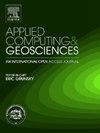Can the anisotropic hydraulic conductivity of an aquifer be determined using surface displacement data? A case study
IF 3.2
Q2 COMPUTER SCIENCE, INTERDISCIPLINARY APPLICATIONS
引用次数: 0
Abstract
Due to geological features such as fractures, some aquifers demonstrate strongly anisotropic hydraulic behavior. The goal of this study is to use a poroelastic model to calculate surface displacements given known pumping rates to predict the potential utility of Interferometric Synthetic Aperture Radar (InSAR) data for inferring information about anisotropic hydraulic conductivity (AHC) in aquifer systems. To this end, we develop a three-dimensional anisotropic poroelastic model mimicking the main features of the 1994 Anderson Junction aquifer test in southwestern Utah with a 24 to 1 ratio of hydraulic conductivity along the principal axes, previously estimated in the literature using traditional well observation techniques. Under suitable model assumptions, our results show that anisotropy in the hydraulic problem leads to a distinctive elliptical surface displacement pattern centered around the pumping well that could be detected with InSAR. We interpret these results in the context of InSAR acquisition constraints and provide guidelines for designing future pumping tests so that InSAR data can be used to its full potential for improving the characterization of aquifers with anisotropic hydraulic behavior.
能否利用地表位移数据确定含水层的各向异性水力导电性?案例研究
由于裂缝等地质特征,一些含水层表现出强烈的各向异性水力特性。本研究的目的是使用孔隙弹性模型计算已知泵送速率下的地表位移,以预测干涉合成孔径雷达(InSAR)数据在推断含水层系统各向异性水力导电性(AHC)信息方面的潜在应用。为此,我们开发了一个三维各向异性孔隙弹性模型,模拟了1994年犹他州西南部Anderson Junction含水层测试的主要特征,其沿主轴的水力导电性比为24比1,这是以前文献中使用传统井观测技术估计的。在适当的模型假设下,我们的研究结果表明,水力问题的各向异性导致以抽油井为中心的独特的椭圆形地表位移模式可以用InSAR检测到。我们在InSAR采集限制的背景下解释这些结果,并为设计未来的抽水试验提供指导,以便InSAR数据可以充分发挥其潜力,改善具有各向异性水力特性的含水层特征。
本文章由计算机程序翻译,如有差异,请以英文原文为准。
求助全文
约1分钟内获得全文
求助全文
来源期刊

Applied Computing and Geosciences
Computer Science-General Computer Science
CiteScore
5.50
自引率
0.00%
发文量
23
审稿时长
5 weeks
 求助内容:
求助内容: 应助结果提醒方式:
应助结果提醒方式:


